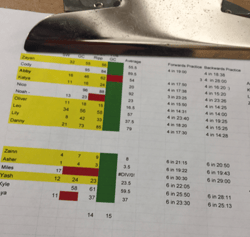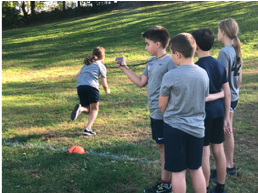When students set their own goals, witnessing their achievements is one of the most rewarding occurrences a teacher can experience. I love coaching cross country at Whitby, because it fosters students’ social and emotional growth in a new context. It also enriches values and skills we seek to deliver in the classroom: setting and achieving realistic goals, developing grit, and building camaraderie.
In cross country, students learn to define their own success from less tangible metrics than winning or losing. Achieving this mindset is a valuable experience for anyone, especially our middle school students.
At practice, I carry a clipboard with a color-coded Excel spreadsheet of race statistics and practice times. The kids think it’s super-nerdy, but they come to realize that my spreadsheet holds the keys for students to make realistic, achievable, goals as it keeps track of their quantifiable improvement.
think it’s super-nerdy, but they come to realize that my spreadsheet holds the keys for students to make realistic, achievable, goals as it keeps track of their quantifiable improvement.
Fifth and sixth graders practice on different days than seventh and eighth graders. This allows sixth graders to take on natural leadership roles by leading warm-ups, sharing race-day experiences, and modeling behavior. At races, students from all grades warm up together. This generates camaraderie and provides opportunities for the older students to become role models.
For my fifth graders, the goal for their first race is simple: finish the race. Once this goal is achieved, students define their next step. This year, a fifth grader shared his simple self-improvement goal. He would ask, “Where did I place last race?” He explained that he wanted to run, “One place better than last time.”
"Running cross country races can be exhausting, but it’s not a student’s athletic ability that propels them past the finish line, but rather a constant testing of their mental fortitude and grit."
During the four years our students spend in the middle school, their physical and emotional growth accelerates at a rapid pace. A student entering in fifth grade will look, think, and feel very differently than they will in eighth grade. Their goals will continue to evolve at the same rate.
 Students of differing abilities can achieve impressive goals in a variety of ways. One of my eighth graders ran well, but never finished a race in the top-five of his class. His goal for the year was simple: finish every race sprinting through the finish line. That season, it was as if you could feel a stiff breeze each time he crossed that white line.
Students of differing abilities can achieve impressive goals in a variety of ways. One of my eighth graders ran well, but never finished a race in the top-five of his class. His goal for the year was simple: finish every race sprinting through the finish line. That season, it was as if you could feel a stiff breeze each time he crossed that white line.
Running cross country races can be exhausting, but it’s not a student’s athletic ability that propels them past the finish line, but rather a constant testing of their mental fortitude and grit.
Running a race becomes a metaphor for overcoming the adversity that will come the students’ way in later life. Cross country students grow in ways that complement what they learn in the classroom, and also helps them develop realistic goal-setting skills that can apply to any activity they choose to pursue.


